Abstract
The primary antibody response to intravenously administered and liposome-associated human serum albumin (HSA) was studied in mice under conditions where no response could be detected against the non-liposome-associated form of the antigen. The positive response against the antigen, entrapped in and/or exposed on the surfaces of liposomes, thus resulted from the adjuvant action of the liposomes. In mice intravenously injected with dichloromethylene diphosphonate (C12MDP) also entrapped in liposomes, all red pulp macrophages, marginal metallophilic macrophages and marginal zone macrophages had disappeared from the spleen 2 days after administration. Twenty-two days after such a treatment red pulp macrophages and marginal metallophilic macrophages had reappeared, but marginal zone macrophages were still absent. In mice injected with liposome-associated HSA at 2 days after treatment with the C12MDP liposomes, anti-HSA responses were severely depressed, but administration of the liposome-associated antigen 22 days after C12MDP liposomes elicited a normal response. These results point to a role of splenic macrophages in the processing of liposome-associated antigens, but marginal zone macrophages, which are located close to the open ends of the white pulp capillaries and thus are the first macrophages to meet the antigens arriving in the marginal zone are not required.
Full text
PDF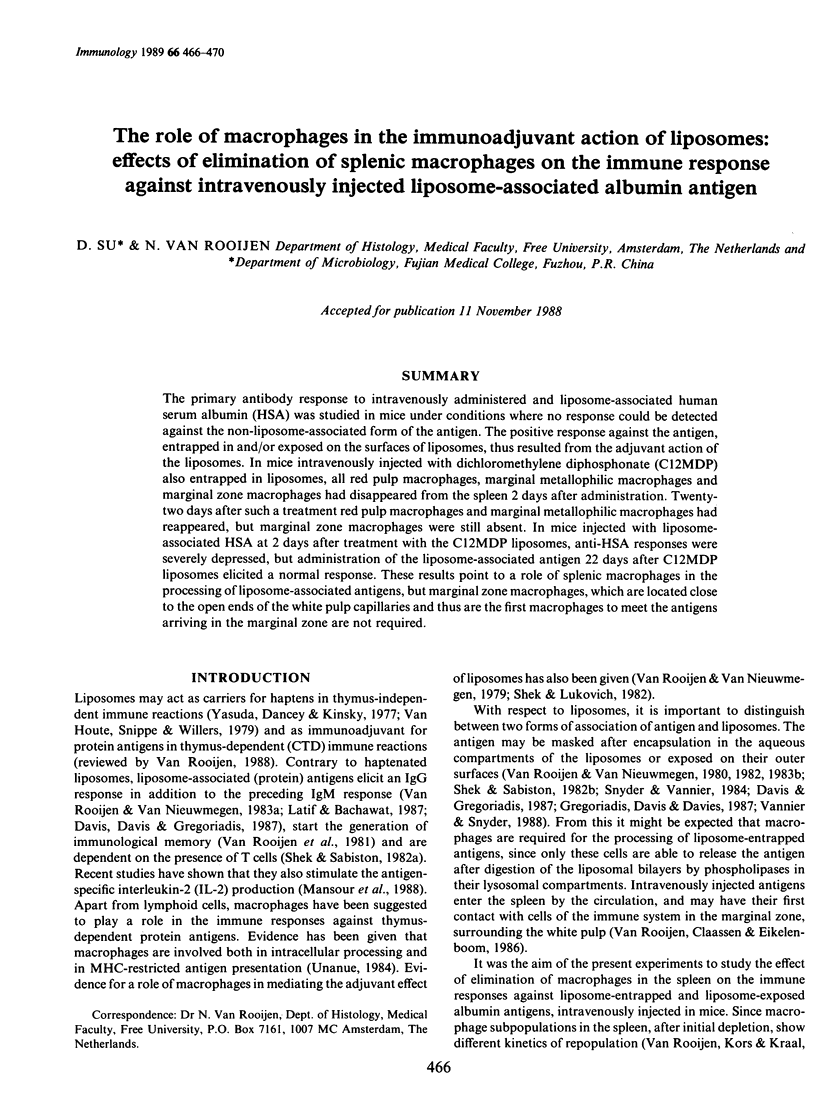
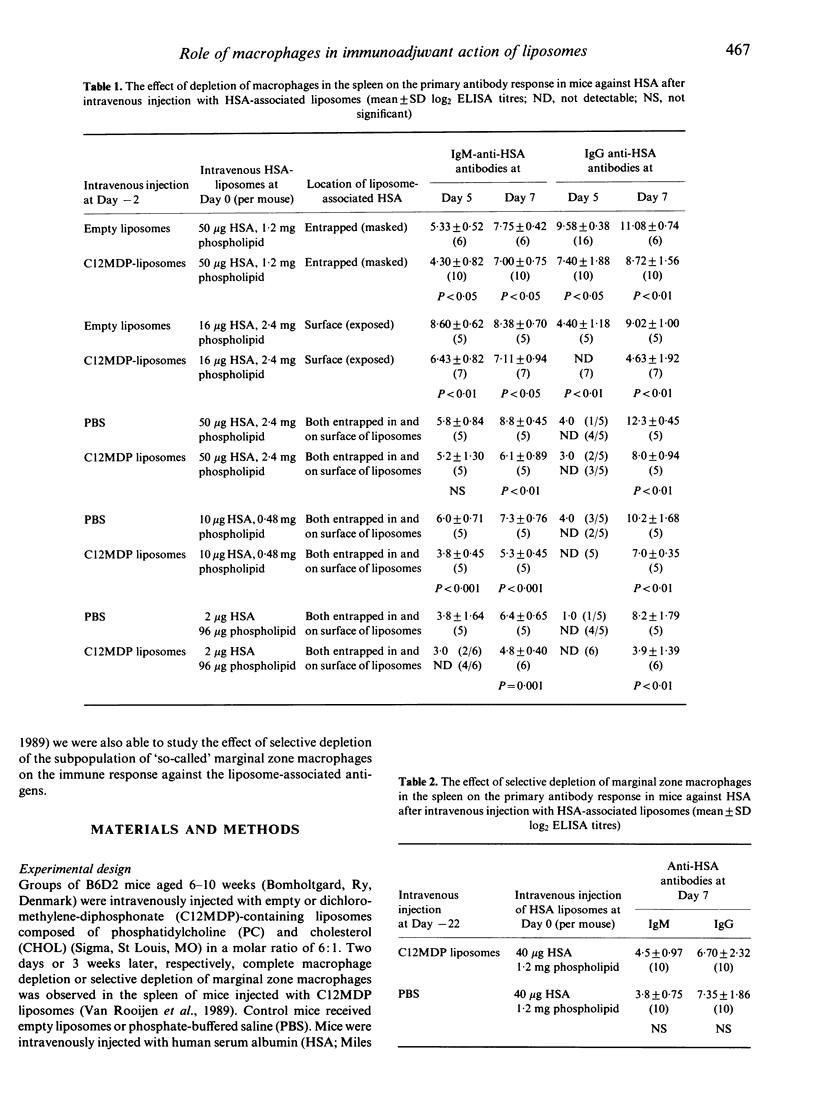
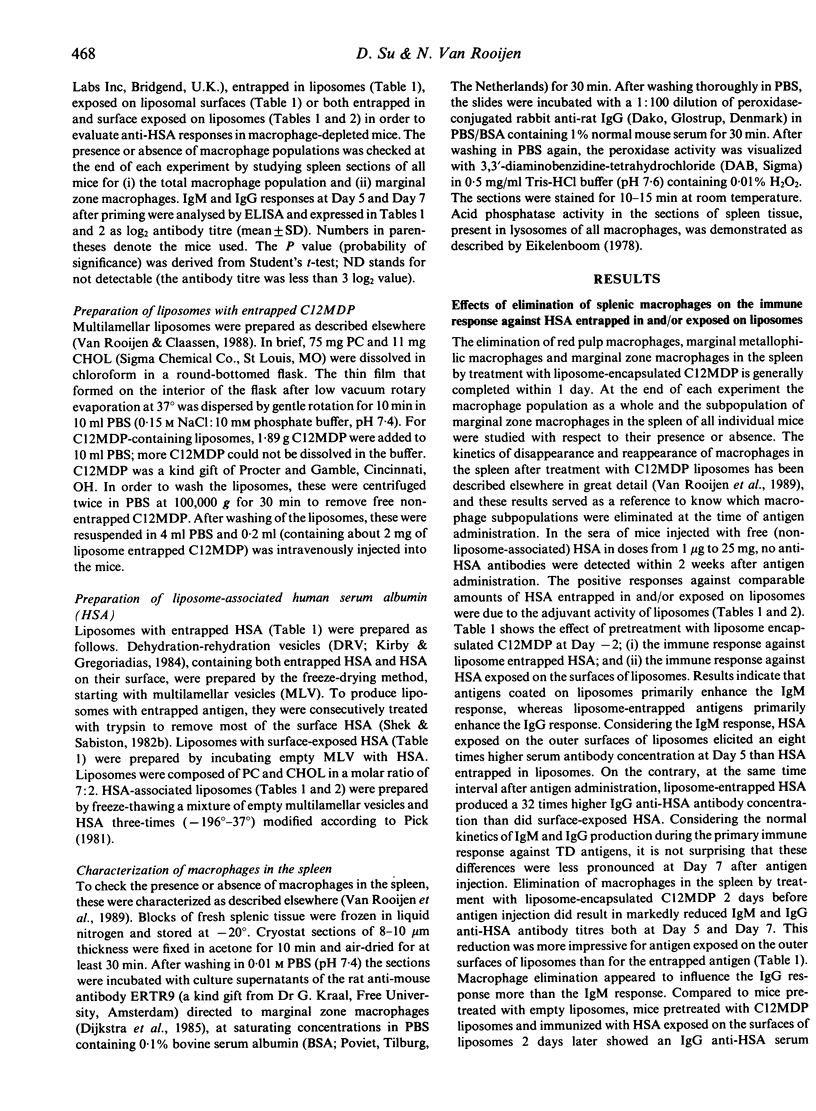
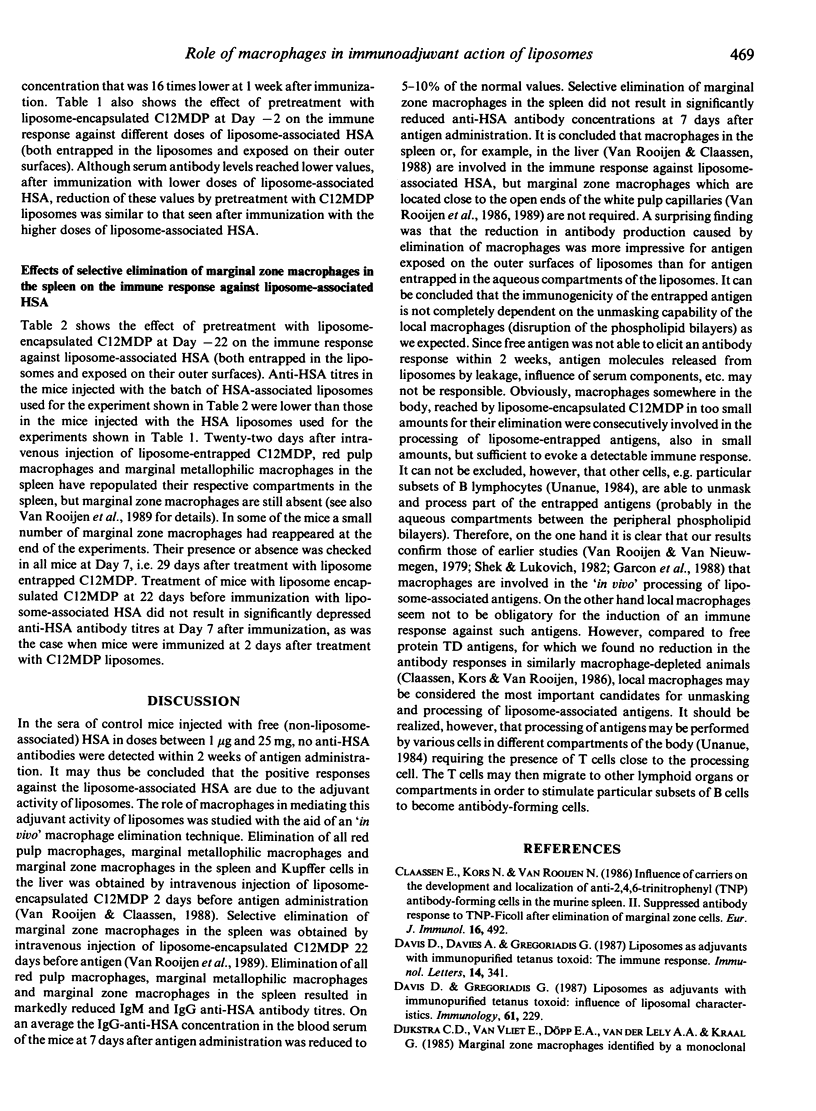
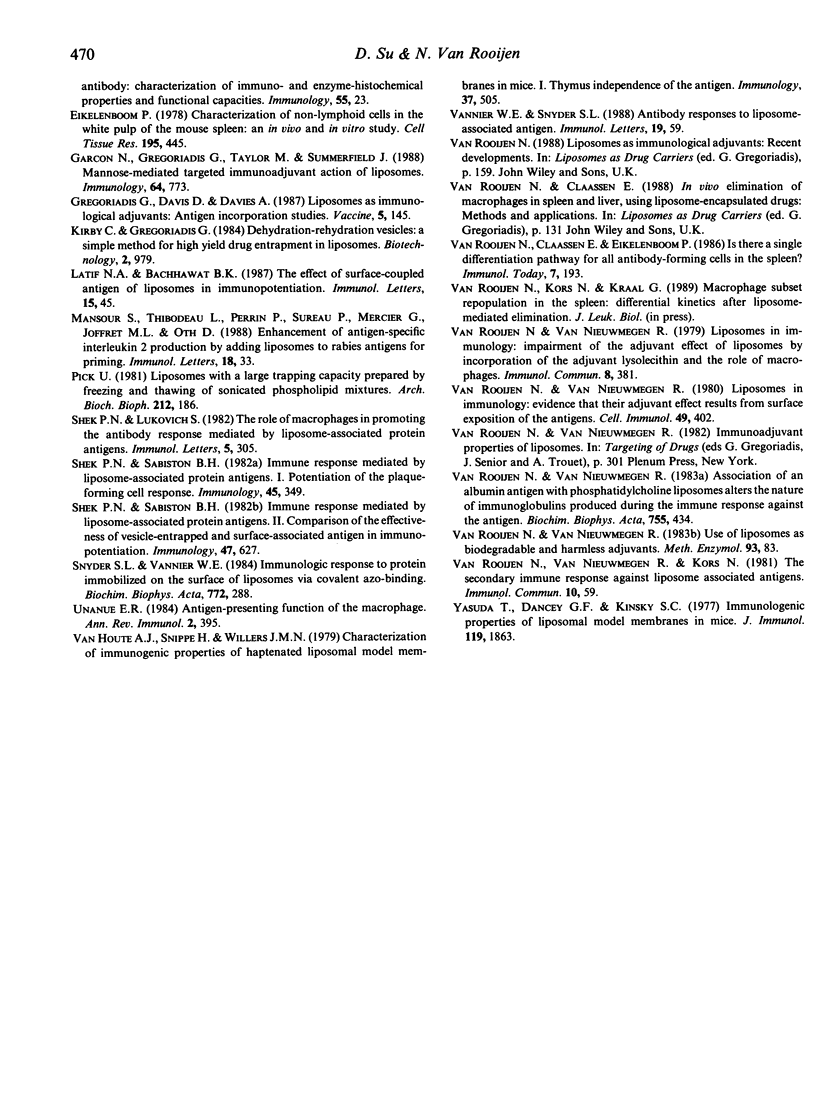
Selected References
These references are in PubMed. This may not be the complete list of references from this article.
- Claassen E., Kors N., Van Rooijen N. Influence of carriers on the development and localization of anti-2,4,6-trinitrophenyl (TNP) antibody-forming cells in the murine spleen. II. Suppressed antibody response to TNP-Ficoll after elimination of marginal zone cells. Eur J Immunol. 1986 May;16(5):492–497. doi: 10.1002/eji.1830160505. [DOI] [PubMed] [Google Scholar]
- Davis D., Davies A., Gregoriadis G. Liposomes as adjuvants with immunopurified tetanus toxoid: the immune response. Immunol Lett. 1987 Apr;14(4):341–348. doi: 10.1016/0165-2478(87)90016-2. [DOI] [PubMed] [Google Scholar]
- Davis D., Gregoriadis G. Liposomes as adjuvants with immunopurified tetanus toxoid: influence of liposomal characteristics. Immunology. 1987 Jun;61(2):229–234. [PMC free article] [PubMed] [Google Scholar]
- Eikelenboom P. Characterization of non-lymphoid cells in the white pulp of the mouse spleen: an in vivo and in vitro study. Cell Tissue Res. 1978 Dec 29;195(3):445–460. doi: 10.1007/BF00233888. [DOI] [PubMed] [Google Scholar]
- Gregoriadis G., Davis D., Davies A. Liposomes as immunological adjuvants: antigen incorporation studies. Vaccine. 1987 Jun;5(2):145–151. doi: 10.1016/0264-410x(87)90063-6. [DOI] [PubMed] [Google Scholar]
- Pick U. Liposomes with a large trapping capacity prepared by freezing and thawing of sonicated phospholipid mixtures. Arch Biochem Biophys. 1981 Nov;212(1):186–194. doi: 10.1016/0003-9861(81)90358-1. [DOI] [PubMed] [Google Scholar]
- Shek P. N., Lukovich S. The role of macrophages in promoting the antibody response mediated by liposome-associated protein antigens. Immunol Lett. 1982;5(6):305–309. doi: 10.1016/0165-2478(82)90118-3. [DOI] [PubMed] [Google Scholar]
- Shek P. N., Sabiston B. H. Immune response mediated by liposome-associated protein antigens. I. Potentiation of the plaque-forming cell response. Immunology. 1982 Feb;45(2):349–356. [PMC free article] [PubMed] [Google Scholar]
- Shek P. N., Sabiston B. H. Immune response mediated by liposome-associated protein antigens. II. Comparison of the effectiveness of vesicle-entrapped and surface-associated antigen in immunopotentiation. Immunology. 1982 Dec;47(4):627–632. [PMC free article] [PubMed] [Google Scholar]
- Snyder S. L., Vannier W. E. Immunologic response to protein immobilized on the surface of liposomes via covalent azo-bonding. Biochim Biophys Acta. 1984 May 30;772(3):288–294. doi: 10.1016/0005-2736(84)90145-7. [DOI] [PubMed] [Google Scholar]
- Unanue E. R. Antigen-presenting function of the macrophage. Annu Rev Immunol. 1984;2:395–428. doi: 10.1146/annurev.iy.02.040184.002143. [DOI] [PubMed] [Google Scholar]
- Van Rooijen N., Van Nieuwmegen R. Association of an albumin antigen with phosphatidylcholine liposomes alters the nature of immunoglobulins produced during the immune response against the antigen. Biochim Biophys Acta. 1983 Feb 22;755(3):434–438. doi: 10.1016/0304-4165(83)90247-7. [DOI] [PubMed] [Google Scholar]
- Yasuda T., Dancey G. F., Kinsky S. C. Immunogenic properties of liposomal model membranes in mice. J Immunol. 1977 Dec;119(6):1863–1867. [PubMed] [Google Scholar]
- van Houte A. J., Snippe H., Willers J. M. Characterization of immunogenic properties of haptenated liposomal model membranes in mice. I. Thymus independence of the antigen. Immunology. 1979 Jun;37(2):505–514. [PMC free article] [PubMed] [Google Scholar]
- van Rooijen N., van Nieuwmegen R., Kors N. The secondary immune response against liposome associated antigens. Immunol Commun. 1981;10(1):59–70. doi: 10.3109/08820138109050687. [DOI] [PubMed] [Google Scholar]
- van Rooijen N., van Nieuwmegen R. Liposomes in immunology: evidence that their adjuvant effect results from surface exposition of the antigens. Cell Immunol. 1980 Feb;49(2):402–407. doi: 10.1016/0008-8749(80)90043-x. [DOI] [PubMed] [Google Scholar]
- van Rooijen N., van Nieuwmegen R. Liposomes in immunology: impairment of the adjuvant effect of liposomes by incorporation of the adjuvant lysolecithin and the role of macrophages. Immunol Commun. 1979;8(4):381–396. doi: 10.3109/08820137909050052. [DOI] [PubMed] [Google Scholar]
- van Rooijen N., van Nieuwmegen R. Use of liposomes as biodegradable and harmless adjuvants. Methods Enzymol. 1983;93:83–95. doi: 10.1016/s0076-6879(83)93036-7. [DOI] [PubMed] [Google Scholar]


